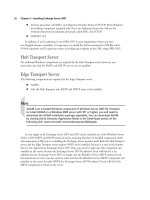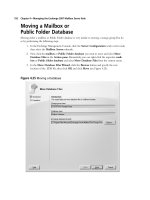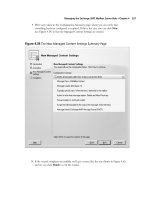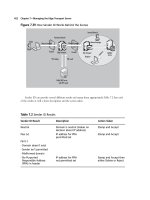Exchange SQL And IIS- P104 potx
Bạn đang xem bản rút gọn của tài liệu. Xem và tải ngay bản đầy đủ của tài liệu tại đây (311.2 KB, 5 trang )
492 Chapter 8 • High Availability for Exchange 2007 Mailbox Servers
Figure 8.16 Specifying the New Path for the NTFS Volume Mount Point
NOTE
Suspending LCR means that all log fi le shipping as well as log fi le replaying is
halted.
Suspending LCR is a straightforward process; it’s done by selecting the respective
storage group in the EMC, then clicking Suspend Local continuous replication in
the Action pane. When you click this link, you’ll need to confi rm that you really want
to suspend LCR. In addition, you’ll have the option of specifying why LCR was
suspended. This comment can be viewed by clicking the View Comment button
on the Properties page of the storage group (shown in Figure 8.17).
High Availability for Exchange 2007 Mailbox Servers • Chapter 8 493
If you’d rather to suspend LCR for a storage group via the EMS, you’ll need to do so using the
Suspend-StorageGroupCopy CMDlet. To suspend LCR for the First Storage Group, where the
comment shown in Figure 8.17 is specifi ed, you should run the following command:
Suspend-StorageGroupCopy -Identity “First Storage Group” -SuspendComment
“Suspending LCR as an integrity check on the passive copy’s transaction
logs and database fi le is required.”
Again, you need to confi rm that you really want to suspend LCR for the storage group. To do so,
type Y for Yes and press Enter.
Resuming Local Continuous Replication
When the active or passive storage group are available again or when you have performed the integrity
check or whatever type of maintenance you have completed, you need to resume LCR for the storage
group. Again, this can be done via either the EMC or the EMS. To perform this task using the EMC, select
the respective storage group and click Resume local continuous replication in the Action pane. When
you do, the warning message shown in Figure 8.18 will appear. Click Ye s and watch the Copy Status
change to Healthy once again. Both log fi le shipping and log fi le replay have now been resumed.
Figure 8.17 Suspending Local Continuous Replication
Figure 8.18 Resuming Local Continuous Replication
494 Chapter 8 • High Availability for Exchange 2007 Mailbox Servers
To resume LCR for a storage group via the EMS, type Resume-StorageGroupCopy-Identity
“First Storage Group”.
Manually Seeding a Database Copy
Before we start talking about how to perform a manual seeding of a database copy, it would be a
good idea to defi ne the term seeding in terms of LCR. Seeding is the process whereby a database is
added to a storage group copy. This can be a blank database or a copy of the database the storage
group uses as the production database. When you enable LCR on a storage group using the EMC or
via the EMS using the Enable-DatabaseCopy and Enable-StorageGroupCopy CMDlets, seeding normally
takes place automatically. If it happens automatically, why should we even care about it, then? The
answer is that there are a few situations in which manually seeding is required. The fi rst is after you
have performed an offl ine defragmentation of the production database belonging to the storage group
for which you have enabled LCR. The second is if or when Exchange detects a corrupt log fi le,
which the Microsoft Exchange Replication Service cannot replay into the database copy. The third is
after a page scrubbing of a database on the active node in a Cluster Continuous Replication (CCR)
setup occurs, and you then want to propagate these changes to the passive node in the CCR setup.
Yes, you’re right, the last one isn’t really related to LCR but only continuous replication in clustered
environments, where CCR is used. We’ll talk much more about CCR later in this chapter.
Seeding a database copy manually can be done using the Update-StorageGroupCopy CMDlet in the
EMS. Before doing so, you must suspend LCR for the respective storage group and then remove any
.log, .chk, .jrs, and .edb fi les from the passive storage group’s database copy, log fi les, and system fi les
paths. To seed the database copy for the First Storage Group, you use the Update-StorageGroupCopy
CMDlet and type Update-StorageGroupCopy-Identity: “First Storage Group”.
Running this command will create a temporary temp-seeding folder, and after a little while the
seeding will take place, as shown in Figure 8.19.
Figure 8.19 Seeding a Mailbox Database Copy
When seeding has taken place, the Microsoft Exchange Replication Service will start to replicate
any .log, .chk, and .jrs fi les to the folder paths. When it’s fi nished, you can resume LCR for the
storage group, and you’re back in business.
High Availability for Exchange 2007 Mailbox Servers • Chapter 8 495
If you don’t want to delete any .log, .chk, .jrs, and .edb fi les manually before running the Update-
StorageGroupCopy CMDlet, you can tell the CMDlet to do it for you using the DeleteExistingFiles
parameter. This method requires that you confi rm the deletion of these fi les, as shown in Figure 8.20.
The method you use is up to you, since they do the same thing.
Figure 8.20 Specifying That the StorageGroupCopy CMDlet Delete Any Existing Files
In addition, you can use the ManualResume parameter if you don’t want replication to occur
automatically on the storage group copy.
Another method available for seeding a database copy is to dismount the database in the EMC,
suspend LCR for the storage group containing the database, and then copy the .edb fi le to the
LCR copy folder using Windows Explorer. When the fi le has been copied, you then mount the
database again using the EMC and resume LCR. Bear in mind that if you choose this method,
your end users will be disconnected until the database is mounted. So unless there’s a specifi c
reason that you would use this method, we recommend that you use the StorageGroupCopy
CMDlet.
Performing an Integrity Check of the
Passive Copy Using Eseutil
It’s a recommended best practice to periodically verify the integrity of the passive storage group copy
to make sure neither the database copy nor any of the log fi les are corrupted. This is done by running
a physical consistency check against both the database copy as well as the log fi les using Exchange
Server Database Utilities (Eseutil.exe).
As mentioned earlier in this chapter, you need to suspend LCR on the storage group for which
you want to verify the integrity of the passive database and log fi les.
To verify the physical integrity of the log fi les that have been replicated to the passive copy of
the storage group, you’ll need to open either a Command Prompt window or the EMS. In either the
Command Prompt window or the EMS you should run Eseutil with the /k switch followed by the
log fi le prefi x of the storage group.
The log fi le prefi x for a storage group can be found under the General tab of the respective
storage group, as shown in Figure 8.21.
496 Chapter 8 • High Availability for Exchange 2007 Mailbox Servers
As you can see, the log fi le prefi x for the First Storage Group typically is E00. To see the
path for the log fi les, refer back to Figure 8.8. For the purpose of this example, the path is
E:\Mailbox\LocalCopies\First Storage Group, so we’ll need to type Eseutil /k
“E:\Mailbox\LocalCopies\First Storage Group\E00”.
This will initiate checksum mode and start verifying each log fi le located under the specifi ed
path, as shown in Figure 8.22. If no corrupted log fi les are detected, the operation will complete
successfully after a few seconds or minutes, depending on how many log fi les are contained in the
respective folder.
Figure 8.21 Log File Prefi x









